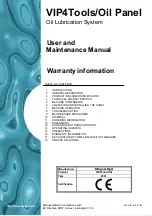
APOLLO DISC-KLEEN FILTER OPERATIONS, MAINTENANCE AND TROUBLESHOOTING GUIDE
•
13
NO WATER GOING THROUGH THE FILTER:
• If the system has upstream and downstream valves around the fi lter, check to make sure they are open. Check that fi eld valves are
open.
• At start-up, the backfl ush valves need a minimum 12 psi to start working. If air is trapped in the system, close the downstream butterfl y
valve so that pressure builds up at the fi lter. Then, slowly open the butterfl y valve to allow water to fl ow to the fi eld.
• Verify that the manual override buttons on all the solenoids are in the correct position. For AC and DC continuous solenoids, the dot in
the round brass knob should be pointing towards the brass base of the solenoid, not towards the black square plastic solenoid coil.
For DC latching solenoids, the green lever should be vertical. See page 6 for illustrations. If all of the manual override buttons are in the
wrong position, water will not fl ow through the fi lter.
• Make sure all vent tubes are venting to atmosphere with no back pressure.
NO BACKFLUSH OPERATION:
Check the Upstream and Downstream Pressure
• The pressure downstream of the fi lter needs to be at least 30 psi during backfl ushing. The Pressure Sustaining Normally Open (PSNO)
Valve should be set to at least 30 psi during backfl ushing.
Check the Command Filter
• Make sure the command fi lter is clean. A clogged command fi lter does not provide command water to the solenoids and backfl ush
valves and the fi lter will not fl ush. Also, make sure the 2” ball valve in front of the command fi lter is open.
Check the Pressure Differential (PD) Gauge
• Make sure the PD gauge is not broken. The set point (the short needle) should be set at 5 psi. The long red needle indicates the
pressure differential at any given time. If the needle reads zero, then the discs are clean. As the red needle moves towards the shorter
(set point) needle, then the discs are getting dirty. When the two needles touch, the backfl ush controller will initiate a fl ush cycle.
• Test the PD gauge while the water is on - disconnect the hydraulic tube from the low pressure port of the gauge (the off center port).
Water will squirt out of the tube; you can bend the tube to temporarily stop the water. The long red needle should move quickly and
touch the short needle. When both needles touch for 15 consecutive seconds, a backfl ush cycle will start.
• If the backfl ush starts, then the PD gauge is working. If there is no fl ush, replace the PD gauge. Re-connect the hydraulic tube to the
PD gauge.
Check if the Filter Discs are Clogged
• To check if the fi lter discs are clogged, turn off the water and confi rm there is no pressure in the system. Open up a fi lter cover and
inspect the discs. If all of the fi lters are completely clogged, the fi lter will not fl ush.
• Remove the discs and clean – refer to the Disc Cleaning Instructions on Page 11 and 12.
• Reassemble the discs on the spine and the fi lter cover, then tighten the clamp.
• Initiate a backfl ush with the backfl ush controller. If the fi lter still doesn’t fl ush, refer to the Check the Backfl ush Controller Section
below.
Check the Backfl ush Controller
• To test the backfl ush controller, initiate a backfl ush by pressing the black button (manual override).
• The solenoid should click and send the fi lter into fl ush mode. After 20 seconds, the solenoid should click again and end the backfl ush.
• If the solenoid clicks, then the solenoid is operating and the control panel is not. If the solenoid does not click, then the solenoid needs
to be replaced
• To test the solenoids: remove the wires of the solenoid from the terminal of the control panel and connect them directly to the power
source. For DC models, touch the wires. For AC models, connect the solenoid wires to the outlet transformer wires.
• If the backfl ush was not initiated, check wires to verify all connections are secure.
• Push the reset button on the front panel and initiate a backfl ush again.
• Flush a fi lter individually by turning the manual override of the solenoid 180 degrees. If that fi lter fl ushes, then the fi lter is working
hydraulically and the problem is electric.
TROUBLESHOOTING
NOTE: Refer to Netafi m USA’s YouTube Channel
for Apollo Troubleshooting Guide Video


































